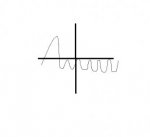How to estimately graph a quartic and quadratic function
- Thread starter Chaim
- Start date
7(x-3)2(x+5)4
That means the zeroes would be 3, and -5
Then wouldn't the 7 have an exponent of 1? So it would be 71
Therefore the graph would go through the x-axis, then bounces off the
x-axis after it hits the even multiplicity or even exponents?
View attachment 1472So like this?
Chaim,
the issue is what is the degree of 7? The degree of 7 is 0.
The degree of that polynomial is still 6.
Hello, Chaim!
The graph has x-intercepts of 3 and -5.
Since they have even multiplicity, the graph is tangent to the x-axis at those points.
The function is a sixth-degree polynomial with a positive leading coefficient.
. . Hence, it opens upward. . ∩∩[−2.5mm]∪∪∪
The derivative is: .y′=14(x−3)(x+5)3(3x−1)
The critical values are: .⎩⎪⎨⎪⎧x=-5x=31x=3minmaxmin⎭⎪⎬⎪⎫
Hence, the graph is shaped like a W.
y=7(x−3)2(x+5)4
That means the zeroes would be 3, and -5. . Right!
Then wouldn't the 7 have an exponent of 1? . So it would be 71 . Yes, but so what?
Therefore, the graph would go through the x-axis, . No
then bounces off the x-axis when it hits the even multiplicity or even exponents? . Yes!
The graph has x-intercepts of 3 and -5.
Since they have even multiplicity, the graph is tangent to the x-axis at those points.
The function is a sixth-degree polynomial with a positive leading coefficient.
. . Hence, it opens upward. . ∩∩[−2.5mm]∪∪∪
The derivative is: .y′=14(x−3)(x+5)3(3x−1)
The critical values are: .⎩⎪⎨⎪⎧x=-5x=31x=3minmaxmin⎭⎪⎬⎪⎫
Hence, the graph is shaped like a W.
Code:
|
* | *
|
* | * *
* *| : * *
* * | : * *
---------*----+-+------*---------
-5 |1/3 3
|Oh I see thanksChaim,
the issue is what is the degree of 7? The degree of 7 is 0.
The degree of that polynomial is still 6.
I was overthinking myself, believing it was the degree of 7 xD
But I forgot it's actually the degree of 6 if you multiply all the exponents together
Oh wow thanks!Hello, Chaim!
The graph has x-intercepts of 3 and -5.
Since they have even multiplicity, the graph is tangent to the x-axis at those points.
The function is a sixth-degree polynomial with a positive leading coefficient.
. . Hence, it opens upward. . ∩∩[−2.5mm]∪∪∪
The derivative is: .y′=14(x−3)(x+5)3(3x−1)
The critical values are: .⎩⎪⎨⎪⎧x=-5x=31x=3minmaxmin⎭⎪⎬⎪⎫
Hence, the graph is shaped like a W.
Code:| * | * | * | * * * *| : * * * * | : * * ---------*----+-+------*--------- -5 |1/3 3 |
I am starting to understand this a bit more now!
At first I thought it meant it will never pass through the x-axis if it was even, but I understand it can bounce off from the top or bottom xD
And I see where you got your maximum point now by factoring, then using the vertex formula (I believe so)
Just wondering, why does it shape like a 'w'?
Cause I thought 'w' were usually quartics, so I overthought again, and thought it would be some weird shape with 6 curves xD
Last edited:
Oh I see thanks
I was overthinking myself, believing it was the degree of 7 xD
But I forgot it's actually the degree of 6 if you >>multiply <<all the exponents together
No, you add all of the (pertinent) exponents together.
So, 2 + 4 = 6.
Then, it is a 6th degree polynomial.

